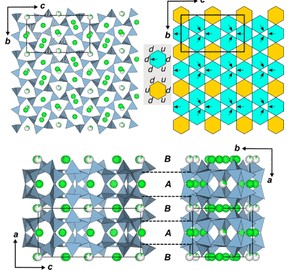The substitution of silicon into SrAl2O4 is of interest for the development of new persistent luminescence phosphors with complementary excitation and emission wavelengths, especially in the form of transparent ceramics or glass-ceramics by the glass-crystallization approach.
The substitution of silicon into SrAl2O4 is of interest for the development of new persistent luminescence phosphors with complementary excitation and emission wavelengths, especially in the form of transparent ceramics or glass-ceramics by the glass-crystallization approach. Application of this approach to the series Sr1–x/2Al2–xSixO4 (0 ≤ x ≤ 1) has previously produced two different solid solutions adopting either the three-dimensional stuffed tridymite structure of SrAl2O4 (0 ≤ x ≤ 0.5), or the two-dimensional hexacelsian structure of SrAl2Si2O8 (0.8 ≤ x ≤ 1.0), with a compositional gap between 0.5 < x < 0.8. Here, we synthesize a solid solution centered around SrAl2SiO6 (x = 0.66), which is accessible in the range 0.60 ≤ x ≤ 0.75 by glass crystallization. The crystal structure of SrAl2SiO6 features an aluminosilicate framework that is related topologically to SrAl2O4 (stuffed tridymite) and also, more distantly, to SrAl2Si2O8 (hexacelsian), representing a stepwise reduction in framework dimensionality across the series. SrAl2SiO6 exhibits an unusual pale blue-green persistent luminescence when doped with Eu2+/Dy3+, and can be produced as powders or transparent glass-ceramic disks. The pale afterglow color, transparency and scalability of these materials are complementary to the dominantly green persistent luminescence of SrAl2O4-based powders or single crystals.
A Strontium Aluminosilicate SrAl2SiO6 Offering a Scalable Route to Persistent Luminescent Materials, Ana Isabel Becerro, Alberto J. Fernandez-Carrion, Gabriel Lozano, lorence Porcher, Maxence Vigier, Kholoud Al Sagir, Emmanuel Veron, Mathieu Allix, Michael J. Pitcher, Chem. Mater. 2025, 37, 22, 9083–9090.


